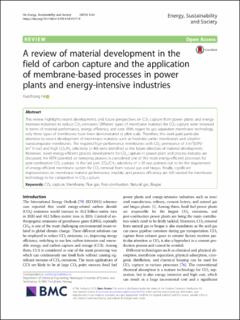| dc.contributor.author | He, Xuezhong | |
| dc.date.accessioned | 2021-09-10T06:18:41Z | |
| dc.date.available | 2021-09-10T06:18:41Z | |
| dc.date.created | 2020-04-23T22:10:22Z | |
| dc.date.issued | 2020 | |
| dc.identifier.issn | 2095-8099 | |
| dc.identifier.uri | https://hdl.handle.net/11250/2775053 | |
| dc.description.abstract | This review highlights recent developments and future perspectives on CO2 capture from power plants and energy-intensive industries to reduce CO2 emissions. Different types of membrane materials for CO2 capture were reviewed in terms of material performance, energy efficiency, and cost. With regard to gas separation membrane technology, only three types of membranes have been demonstrated at pilot scale. Therefore, this work paid particular attention to recent development of membrane materials such as fixed-site-carrier membranes and ultrathin nanocomposite membranes. The required high-performance membranes with CO2 permeance of 3 m3(STP)/(m2 h bar) and high CO2/N2 selectivity (> 40) were identified as the future direction of material development. Moreover, novel energy-efficient process development for CO2 capture in power plant and process industry are discussed; the MTR patented air sweeping process is considered one of the most energy-efficient processes for post-combustion CO2 capture. In the last part, CO2/CH4 selectivity of > 30 was pointed out to be the requirement of energy-efficient membrane system for CO2 removal from natural gas and biogas. Finally, significant improvements on membrane material performance, module, and process efficiency are still needed for membrane technology to be competitive in CO2 capture. | en_US |
| dc.language.iso | eng | en_US |
| dc.publisher | BMC (part of Springer Nature) | en_US |
| dc.rights | Navngivelse 4.0 Internasjonal | * |
| dc.rights.uri | http://creativecommons.org/licenses/by/4.0/deed.no | * |
| dc.title | Polyvinylamine based Facilitated Transport Membranes for Post-combustion CO2 Capture: Challenges and Perspectives from Materials to Processes | en_US |
| dc.type | Peer reviewed | en_US |
| dc.type | Journal article | en_US |
| dc.description.version | publishedVersion | en_US |
| dc.source.pagenumber | 1-14 | en_US |
| dc.source.volume | 8 | en_US |
| dc.source.journal | Engineering | en_US |
| dc.source.issue | 34 | en_US |
| dc.identifier.doi | 10.1186/s13705-018-0177-9 | |
| dc.identifier.cristin | 1807770 | |
| dc.description.localcode | This article is distributed under the terms of the Creative Commons Attribution 4.0 International License (http://creativecommons.org/licenses/by/4.0/), which permits unrestricted use, distribution, and reproduction in any medium, provided you give appropriate credit to the original author(s) and the source, provide a link to the Creative Commons license, and indicate if changes were made. | en_US |
| cristin.ispublished | false | |
| cristin.fulltext | postprint | |
| cristin.qualitycode | 1 | |

